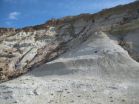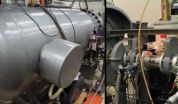(Press-News.org) New York, NY, March 4, 2013 – In a new phase III trial mirabegron, a β3-adrenoceptor agonist, given once daily for 12 weeks, reduced the frequency of incontinence episodes and number of daily urinations, and improved urgency and nocturia in adults with overactive bladder (OAB) compared to those in a placebo group. The incidence of common adverse events (hypertension, urinary tract infection, headache, nasopharyngitis) was similar in the mirabegron and placebo groups in this study. Rates of dry mouth and constipation were similar in the drug and placebo groups. The study is published in the Journal of Urology®.
"Mirabegron is a first in class therapeutic agent with a mechanism of action distinct from that of antimuscarinic agents," says urologist Victor W. Nitti, MD, of the NYU Langone Medical Center. "While antimuscarinic agents are the current pharmacological mainstay for OAB, some patients have a suboptimal response or experience side effects such as dry mouth or constipation. The result is that a high proportion of patients on antimuscarinic drugs discontinue therapy, with only 25% remaining on therapy at one year. We need an alternative therapy for some of these patients."
This randomized, parallel group, double-blind phase III study comprising 1329 patients was conducted at 132 sites in the U.S. and Canada. Those eligible for the study voided 8 or more times daily and experienced 3 or more urgency episodes with or without incontinence over a 3-day period. After 2 weeks of receiving placebo, 454 patients were randomized to continue to receive placebo, 442 were given 50 mg mirabegron and 433 received 100 mg mirabegron daily for 12 weeks.
Compared to the placebo group, both mirabegron treatment groups showed statistically significant (p END
Study shows mirabegron effective and well tolerated for overactive bladder
New option for patients bothered by antimuscarinic side effects, reported in the Journal of Urology
2013-03-05
ELSE PRESS RELEASES FROM THIS DATE:
New research confirms plight of bumble bees, persistence of other bees in Northeast
2013-03-05
A new study shows that although certain bumble bees are at risk, other bee species in the northeastern United States persisted across a 140-year period despite expanding human populations and changing land use. Led by Rutgers University and based extensively on historical specimens from the American Museum of Natural History and nine other bee collections, the study informs conservation efforts aimed at protecting native bee species and the important pollinator services they provide. The results are published today in Proceedings of the National Academy of Sciences.
Eighty-seven ...
Protein synthesis blocker may hold key to reducing effects of traumatic events
2013-03-05
Reducing fear and stress following a traumatic event could be as simple as providing a protein synthesis blocker to the brain, report a team of researchers from McLean Hospital, Harvard Medical School, McGill University, and Massachusetts General Hospital in a paper published in the March 4 issue of Proceedings of the National Academy of Sciences.
"This is an important basic neuroscience finding that has the potential to have clinical implications for the way individuals with posttraumatic stress disorder are treated," said Vadim Bolshakov, PhD, director of the Cellular ...
Stress hormone foreshadows postpartum depression in new mothers
2013-03-05
Women who receive strong social support from their families during pregnancy appear to be protected from sharp increases in a particular stress hormone, making them less likely to develop postpartum depression, according to a new study published in Clinical Psychological Science, a journal of the Association for Psychological Science.
"Now we have some clue as to how support might 'get under the skin' in pregnancy, dampening down a mother's stress hormone, and thereby helping to reduce her risk for postpartum depression," said Jennifer Hahn-Holbrook, a UCLA National Institute ...
Vitamin deficiency screening needed for refugees
2013-03-05
New research from the University of Adelaide has discovered a high prevalence of vitamin B12 deficiency among refugees, prompting calls for refugees to be routinely screened for the problem soon after they arrive.
Vitamin B12 deficiency is a sign of severe malnourishment and can result in permanent damage to the nervous system. For women of child-bearing age, vitamin B12 deficiency can lead to developmental defects in their unborn children. If left untreated, the deficiency could be fatal.
In the first study of its kind in the world, researchers from the University ...
'True grit' erodes assumptions about evolution
2013-03-05
Dining on field grasses would be ruinous to human teeth, but mammals such as horses, rhinos and gazelles evolved long, strong teeth that are up to the task.
New research led by the University of Washington challenges the 140-year-old assumption that finding fossilized remains of prehistoric animals with such teeth meant the animals were living in grasslands and savannas. Instead it appears certain South American mammals evolved the teeth in response to the gritty dust and volcanic ash they encountered while feeding in an ancient tropical forest.
The new work was conducted ...
MIT researchers develop solar-to-fuel roadmap for crystalline silicon
2013-03-05
CAMBRIDGE, MA -- Bringing the concept of an "artificial leaf" closer to reality, a team of researchers at MIT has published a detailed analysis of all the factors that could limit the efficiency of such a system. The new analysis lays out a roadmap for a research program to improve the efficiency of these systems, and could quickly lead to the production of a practical, inexpensive and commercially viable prototype.
Such a system would use sunlight to produce a storable fuel, such as hydrogen, instead of electricity for immediate use. This fuel could then be used on demand ...
Lawrence Livermore helps find link to arsenic-contaminated groundwater
2013-03-05
Human activities are not the primary cause of arsenic found in groundwater in Bangladesh.
Instead, a team of researchers from Lawrence Livermore National Laboratory, Barnard College, Columbia University, University of Dhaka, Desert Research Institute and University of Tennessee found that the arsenic in groundwater in the region is part of a natural process that predates any recent human interaction, such as intensive pumping.
The results appear in the March 4 edition of the Proceedings of the National Academy of Sciences.
Millions of people in Bangladesh and neighboring ...
BUSM researchers use goal-oriented therapy to treat diabetic neuropathies
2013-03-05
(Boston) – Researchers at Boston University School of Medicine (BUSM) and VA Boston Healthcare System (VA BHS) have found that cognitive behavioral therapy (CBT) can help relieve pain for people with painful diabetic neuropathies. The study, which is the first of its kind to examine this treatment for people with type II diabetes mellitus, is published in the March issue of the Journal of Pain.
Type II diabetes mellitus is the most common form of the disease and affects more than 20 million Americans. The onset of type II diabetes mellitus is often gradual, occurring ...
How the brain loses and regains consciousness
2013-03-05
CAMBRIDGE, MA -- Since the mid-1800s, doctors have used drugs to induce general anesthesia in patients undergoing surgery. Despite their widespread use, little is known about how these drugs create such a profound loss of consciousness.
In a new study that tracked brain activity in human volunteers over a two-hour period as they lost and regained consciousness, researchers from MIT and Massachusetts General Hospital (MGH) have identified distinctive brain patterns associated with different stages of general anesthesia. The findings shed light on how one commonly used ...
NASA Goddard lab works at extreme edge of cosmic ice
2013-03-05
VIDEO:
NASA scientists at the Goddard Cosmic Ice Lab are studying a kind of chemistry almost never found on Earth. The extreme cold, hard vacuum, and high radiation environment of space...
Click here for more information.
Behind locked doors, in a lab built like a bomb shelter, Perry Gerakines makes something ordinary yet truly alien: ice. This isn't the ice of snowflakes or ice cubes. No, this ice needs such intense cold and low pressure to form that the right conditions ...
LAST 30 PRESS RELEASES:
New modeling approach sheds light on rare gut disease
Study documents potentially hazardous flame retardants in firefighter gear
Can certain bacteria regulate aging of the immune system and its related alterations?
AI model helps diagnose often undetected heart disease from simple EKG
There are fewer online trolls than people think
Cell membrane fluctuations produce electricity
Jeonbuk National University study shows positive parenting can protect adolescents against self-harm
Surface-engineered ZnO nanocrystals to tackle perfluoroalkyl substance contamination
This new understanding of T cell receptors may improve cancer immunotherapies
A new fossil face sheds light on early migrations of ancient human ancestor
A new immunotherapy approach could work for many types of cancer
A new way to diagnose deadly lung infections and save lives
40 percent of MRI signals do not correspond to actual brain activity
How brain-inspired algorithms could drive down AI energy costs
Gum disease may be linked to plaque buildup in arteries, higher risk of major CVD events
Contrails are a major driver of aviation’s climate impact
Structure of dopamine-releasing neurons relates to the type of circuits they form for smell-processing
Reducing social isolation protects the brain in later life
Keeping the heart healthy increases longevity even after cancer
Young adults commonly mix cannabis with nicotine and tobacco
Comprehensive review illuminates tau protein's dual nature in brain health, disease, and emerging psychiatric connections
Book prepares K-12 leaders for the next public health crisis
Storms in the Southern Ocean mitigates global warming
Seals on the move: Research reveals key data for offshore development and international ecology
Sports injuries sustained during your period might be more severe
World's first successful 2 Tbit/s free-space optical communication using small optical terminals mountable on satellites and HAPS
Can intimate relationships affect your heart? New study says ‘yes’
Scalable and healable gradient textiles for multi‑scenario radiative cooling via bicomponent blow spinning
Research shows informed traders never let a good climate crisis go to waste
Intelligent XGBoost framework enhances asphalt pavement skid resistance assessment
[Press-News.org] Study shows mirabegron effective and well tolerated for overactive bladderNew option for patients bothered by antimuscarinic side effects, reported in the Journal of Urology


